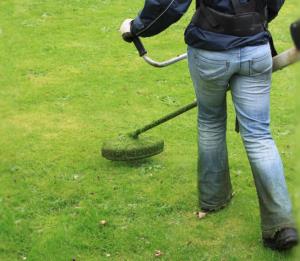**NOTE – WE ARE CURRENTLY ONLY AVAILABLE FOR MUNICIPAL / COMMERCIAL WORK.**
** WE CAN NOT TAKE ON ANY MORE PRIVATE-DOMESTIC CLIENTS AT THE MOMENT. SINCERE APOLOGIES!**
You can get an immediate cost estimate for cutting a domestic lawn via the LawnCalc application. For more details, visit our pricing page.
Commercial and municipal sites may attract “bulk” discount rates, contact us for a quote.
Frequency of cut
Our grass-cutting crews visit almost every corner of Shetland, approximately fortnightly, during the summer. The cutting season typically spans from April to October.
Frequency is the most important aspect of specification. Most gardens and commercial premises are cut approx fortnightly (about 11 – 15 visits).
“Fine” turf is cut more often. Rougher areas are done less often, perhaps monthly. We’ll tailor the standard of work to suit your needs (although in some rural areas, we might not be able to attend any more often than fortnightly).
Grass clippings
A few options here:
- Clippings “scattered”. This is the cheapest option, and offers great value. If cuts are done reasonably frequently, this specification can actually work really well for reasonably thin-growing domestic lawn areas, but is more usually specified for municipal ground, commercial sites, or rougher areas.
- Clippings “mulched”. This is the option the vast majority of our customers specify, and offers good value for money. Special “double” sets of blades cut the clippings into smaller pieces, and rather than being bagged, are returned from the mower deck directly to the lawn, and left “in-situ”. Additional effort is also made to spread the clippings, which helps them to disappear reasonably quickly. Mulching usually only works reliably if cuts are done reasonably frequently, i.e. approximately once every 10 – 14 days at the most. Doesn’t work so well in very fertile areas, or if the ground is wet at the time of the cut.
- Clippings “composted” or left onsite. We gather the clippings off the lawn, but leave them onsite. Tell us where you want us to put your clippings, e.g. an onsite compost heap, or scattered / carefully heaped around the base of some trees, or simply left in bags for you to deal with.
- Clippings collected. This arguably gives the best standard of finish, but is the most time-consuming and expensive. Waste-disposal charges, landfill tax etc come to a considerable sum, and unfortunately these overheads must be passed on to the customer.
Height of cut
 Usually largely dictated by the frequency of cut. Also depends on how flat or uneven the ground is. It tends to be that flat areas which are cut frequently are cut quite low, whereas rough areas done infrequently are trimmed at a much higher setting.
Usually largely dictated by the frequency of cut. Also depends on how flat or uneven the ground is. It tends to be that flat areas which are cut frequently are cut quite low, whereas rough areas done infrequently are trimmed at a much higher setting.
Having said this, if we’re doing a one-off “renovative” cut, and removing the clippings, we will usually take it “to the bone”.
Pricing
For details on costs, visit our pricing page.

